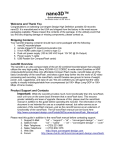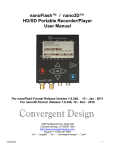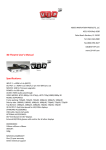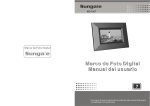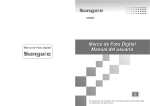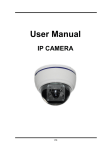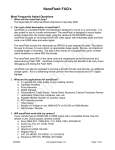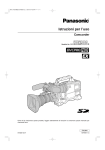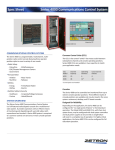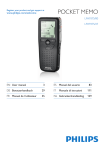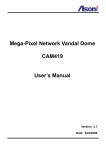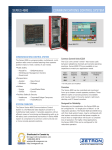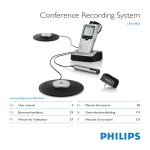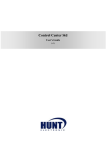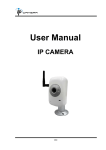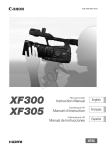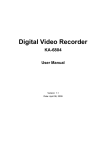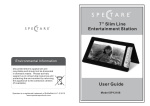Download Flash XDR Release Notes
Transcript
nanoFlash Firmware Release Notes
Release Version 1.6.245 ( 16 – Dec - 2010 ) o Fixed trigger delay feature (System->Timecode->Trigger Delay).
o Fixed timecode in 720p24/25/30 long records, file to file. Previously, the timecode in files after the 1st file
of a long record would not have the correct timecode.
o Fixed Remote Record Tally light, which sometimes was flashing prematurely. The light now flashes
appropriately, meaning the tally light flashes during record when less than 5 minutes record time remains
across the inserted CF cards.
o Improved locking to Standard Definition sources. However, in rare cases with some atypical SD-SDI
sources, such as a source going through an analog to digital converter, the loop-through will not display
correctly, but the files will be recorded correctly.
Known issues / Limitations (1.6.245) :
o During playback, timecode will sometimes momentarily be displayed incorrectly on the lcd screen.
o 720P24 / 25 / 30 playback from the nanoFlash is not supported at this time. Loop-through of these
formats during live or record mode is only supported with Video->E to E turned on.
o SD playback out of the HDMI port is not supported.
o HDMI in / out: 2 channel audio support only. HD-SDI in / out supports 0, 2, 4, or 8 channel audio.
SD-SDI: 2 channel audio only (records as 24-bit 4 channel audio IMX, top 2 channels are blanked
out).
o Avid Media Composer: does not support Long-Gop MXF files 100 Mbit and above. (All I-Frame
files, all bit rates are supported.) Does not support any 720p24/25/30 files at 50 Mbit and above.
o Initial release of Edius 6 does not support nanoFlash MXF files. Edius is in the process of
addressing this.
o Some camera compatibility limitations exist, please see Addendum A in user manual for the known
limitations.
o Other NLE / Viewing limitations may exist, please see the appropriate Addenda in the manual.
Release Version 1.6.226 ( 12 - Nov - 2010 ) o Fixed green frame bug at beginning of long-Gop MXF files when brought into Sony Vegas.
o Added timecode trigger delay (System->Timecode->Trigger Delay), in number of seconds. When used in
combination with “Timecode” trigger or “TC > Last TC” trigger (System->Trigger), nanoFlash will delay start
of record the specified number of seconds in the Trigger Delay. This feature is beneficial to better match
the timecode of some tape-based cameras which can shift the camera timecode unexpectedly at the
beginning of camera record. This feature also helps to prevent the nanoFlash from creating very small files
in Timecode trigger mode if the camera is shifting it's timecode around while ejecting / inserting media.
o SD Aspect Ratio (Video->SD Aspect Ratio) fixed. In earlier versions, this was not always being applied
correctly to files.
o Added lock-out of drop-frame timecode in 720p24 mode. ( In some NLE's, drop-frame timecode
is not allowed in 720p24 mode. )
o Fixed timecode bug in 720p24 mode with pulldown removal. Timecode was getting
inadvertently doubled in this mode, but is now correct.
o LTC timecode accuracy improved.
o Expanded range of analog audio input (Audio->Analog Settings->Gain In) : -99 to +44 dB.
o Improved MPG support / compatibility with DVD authoring programs.
o Added ability to create new file during record by pressing Record button while in Timecode
Trigger mode. (This method was previously available only with Record button as the Record
trigger (System->Trigger) ).
o Fixed compatibility with newer Delkin CF cards 420x and 450x.
o Added support for playing CF cards from Canon XF305, 50 Mbit.
o Avid has added AMA compatibility, “Link to AMA Files”, for nanoFlash MXF files. Allows access
of files within Avid without having to import (copy in) the files. Requires Avid Patch 5.0.3.2 (see
link in user manual).
o Added Vertical image flip (Video->Flip V) and Horizontal image flip (Video->Flip H) options for
flipping images as desired from camera outputs in which the camera lens produces an inverted
image.
o Added hot-swap support. An inserted CF card may be pulled from it's CF slot during Record if
the card is not being recorded to. A CF card may also be inserted to an empty CF slot during
record to facilitate lengthy records. It is preferable that such a CF card inserted during record was
formatted on a nanoFlash – however, such a nanoFlash-formatted card may contain previously
recorded video. Also, a CF card inserted during record may be from a formatting on a computer in
a compatible FAT32 formatting (please test first, ahead of time, that a computer-formatted card is
accepted by the nanoFlash). Please note that, as before, if any files are manually deleted from
or copied onto a CF card from a computer, the card must be formatted again before use for
recording in nanoFlash.
o Added “skip to next card” feature during record, by pressing the RECORD button twice in quick
succession. The nanoFlash will continue to record, without missing any data, but will immediately
close the current file, jump to the next card, and continue recording (assuming there is space
available on the next card). If there is no space available on the next card, the behavior will be
treated the same as a single RECORD button press during record, namely that the nanoFlash will
close the current file and begin a new file on the same card (again, without missing any data).
Note: when using “Skip to Next Card”, allow 5 to 10 seconds for the recording to transfer to the
other card before attempting to remove original card – you can watch the CF cards' status lights to
determine when the transition has completed, as the card being recorded to will have a flashing
red light indicator.
o Added support for saving and restoring menu settings for nanoFlash. To save your current
settings, use the System->Create Menu.stg option to a blank or formatted CF card. You can save
up to 20 settings files onto a single card. To restore your settings, insert a CF card which contains
a }CFG{ folder with up to 20 Men.stg files within this folder. (The prefix “Menu” in Menu.stg may
be renamed as you prefer. ) You will then be prompted to choose which setting to restore. It is
preferable to use the same firmware version on nanoFlash for saving and restoring a given
setting. Please note that all settings will be restored except the Unit Id (the 1st 2 digits in the
System->File= option) and the Clip Number (middle 3 digits in System->File= ), which are always
preserved and must be changed manually.
o Low power mode has been re-activated (System->Power Saving->Auto Sleep). This mode
behaves the same as before, as discussed in the user manual, except that in the process of
waking up the nanoFlash is completely rebooted, which takes 5 to 7 seconds to complete.
o Added Rs232 Serial control capability through the remote Rs232 connection, allowing users to
remotely control the nanoFlash by developing a custom Rs232 controller. (See “Serial Rs232
Control” Addendum in the user manual. ) This is an add-on cost option.
o Fixed rare single frame corruption in connection with some SanDisk Extreme and Extreme Pro
CF cards.
o Fixed potential file corruption if recording Standard Definition, and Audio->Record Channels is
set to 0. The Record Channels value is now automatically raised to 2 channels in this case.
o Improved recovery from temporary loss of video input over HDMI during record.
o Improved recovery from temporary loss of any video input in MPG record mode.
Known issues (1.6.226) :
o 720P24 / 25 / 30 playback from the nanoFlash is not supported at this time.
o SD playback out of the HDMI port is not supported.
o Pulldown removal from JVC 700 requires turning the nanoFlash on 1st, then the camera, to work
properly.
o HDMI in / out: 2 channel audio support only. SDI in / out supports 0, 2, 4, or 8 channel audio.
o Avid Media Composer: does not support Long-Gop MXF files 100 Mbit and above. (All I-Frame
files, all bit rates are supported.) Does not support any 720p24/25/30 files at 50 Mbit and above.
Release Version 1.6.29 ( 29 – June - 2010 ) o Fixed rare bug in which incorrect frame sizes are written to file, possibly introduced in version 1.6.18 .
o Fixed bug in Crank mode, in which during long records, all files after the 1st file would not use the
cranked rate properly.
o Low power mode (System->Power Saving) has been disabled in this release, due to occasional
trouble coming out of low power mode and re-locking to the video source (a problem that has
been present for some time, in earlier releases as well)
Known issues (1.6.29) :
o 720P24 / 25 / 30 playback from the nanoFlash is not supported at this time.
o 720P24 recordings, drop frame timecode option is not locked out, but should be (720p24 with drop
frame is not allowed by some computer software such as the XDCAM Viewer). Be sure to turn off
drop frame from the camera and the nanoFlash menu if recording 720p24.
o Low power mode (System->Power Saving) does not always properly recover when the unit is
woken back up, on rare occasions the unit will not re-lock to the incoming video.
o Pulldown removal from JVC 700 requires turning the nanoFlash on 1st, then the camera, to work
properly.
o HDMI in / out: 2 channel audio support only. SDI in / out supports 0, 2, 4, or 8 channel audio.
Beta Version 1.6.18 ( 23 – June - 2010 ) o Fixed Remote trigger bug introduced in 1.5.249 beta, in which file corruption could occur when using
Remote trigger option.
o Corrected errant “Intermittent Source” which appeared on nanoFlash especially in 720p mode from
cameras such as the Panasonic HDX900 during record, and would cause some seconds' loss of footage.
o Repaired playback from nanoFlash of Standard Def, timecode and audio are now properly played back.
o Fixed Screen Tally option (Video → Screen Tally), a red bar will be displayed on the output (SDI or HDMI)
during record. Also be sure to turn on Video → E to E setting to use this.
o Please note that we mistakenly stated for version 1.5.249 that Remote trigger, when used with 2 or more
nanoFlashes cabled to a single remote cable, would start and stop the nanoFlashes on the same frame.
This feature is not yet present in the firmware, but will very possibly be added in the near future. (This is
available, however, in the nano3D option. )
o Added more feedback when “Intermittent Source” or loss of source occurs, including information related
to specific nanoFlash hardware such as “VCXO out of range”. Please contact technical support if a
message appears relating to “VCXO”.
o Changed menu option to select File Format (in the System menu) : the option is now under “File= “ (also
in the System menu. Scroll to the far right (using right arrow) of the “ File= “ menu option to set the file
format: .MOV, .MXF, or .MPG . The explicit “File Format” option has been removed.
o Improved reliability in .MPG file format.
Known issues (1.6.18) :
o 720P24 / 25 / 30 playback from the nanoFlash is not supported at this time.
o Low power mode (System->Power Saving) does not always properly recover when the unit is
woken back up, on rare occasions the unit will not re-lock to the incoming video.
o Pulldown removal from JVC 700 requires turning the nanoFlash on 1st, then the camera, to work
properly.
o HDMI in / out: 2 channel audio support only. SDI in / out supports 0, 2, 4, or 8 channel audio.
Beta Version 1.5.249 ( 27 – May - 2010 ) o Improved function in Power Saving mode (System->Power Saving)
o Eliminated rare horizontally shifted video in 1080p25 recordings.
o Added error correction for minor errors in incoming SDI stream (instead of losing the signal
momentarily), which will minimize or remove “intermittent source”
o Improved locking to LTC timecode with 1080p24 input
o Fixed audio / video sync during playback from nanoFlash.
o Changed Standard Def IMX (MXF files), number of audio channels from 8 channel 16 bit to 4
channel 24 bit (with only the 1st 2 channels actually used). The IMX specification requires one of
the 2 above mentioned options, the 2nd option is now used to support 24 bit audio.
o Fixed bug in 8 channel audio, HD MXF recordings, which improves compatibility with Edius.
o Added Screen Tally option (Video->Screen Tally), which places a red bar on the output to
indicate unit is recording. Video->E to E must be turned on for Screen Tally to work correctly.
o If recording using a Remote Trigger (System->Trigger), and the remote cable is running to 2 or
more nanoFlashes, all nanoFlashes will start recording on the same frame or within a frame of
each other.
o Turned off “Read Only” status for all recorded files.
o Improved performance in MPG file mode.
o Creation Time / Date is now correctly stored in .MXF files.
o Corrected bug which blocked recording after “No Last Clip” message.
o Improved Timecode Trigger behavior.
o Changed “Unit ID” in System menu to “File=”, which allows user to set the 1 st 2 digits /
characters of the file name as before (formerly the Unit ID), and additionally the next 3 digits (the
clip number). Take care to avoid duplicate file names on the same CF card.
Known issues (1.5.249) :
o 720P24 / 25 / 30 playback from the nanoFlash is not supported at this time.
o Pulldown removal from JVC 700 requires turning the nanoFlash on 1st, then the camera, to work
properly.
o HDMI in / out: 2 channel audio support only. SDI in / out supports 0, 2, 4, or 8 channel audio.
o Vegas 9.0c: displays green frame at start of long-GOP clips, I-Frame only recordings will
periodically display black frames. (Not specific to a nanoFlash firmware version)
o Vegas 9.0d fixed I-Frame
Release Version 1.5.126 ( 6 – Apr - 10 ) o Added menu option Video->720p60 to 30, 720p50 to 25. Cuts the frame rate in half for incoming 720p60
or 720p50 signals. Useful, for example, with cameras with a 720p30 or 720p25 mode which then double
the frame rate of the camera's SDI output. The nanoFlash bit rate in this mode is applied to the reduced
frame rate. For example, @ 280 Mbit from a 720p50 source reduced to 720p25, the 280 Mbit applies
across 25 frames.
o Added menu option System->Trigger->Remote & Record, in which either the Remote Switch or
the Record button can be used for triggering record.
o Added separate menu option System->Trigger-> “TC > Last TC” . In this mode, the nanoFlash
will only trigger to record if the incoming timecode is greater than the ending timecode of the last
recorded clip. This helps to minimize unexpected recordings, for example when inserting or
removing media in the camera, or playing back video off of the camera's internal media. Be
aware, however, that if the camera's timecode is re-set to a smaller value, the nanoFlash may not
trigger from the timecode unless the nanoFlash is then turned off and back on.
o The menu option System->Trigger->Timecode can trigger at any time that the timecode is
increasing, unlike the above mentioned “TC > Last TC” . This may create unexpected short
recordings due to camera timecode behavior.
o Added menu option Audio->Audio Channels Monitoring, for monitoring specific channels on the
headphones output. Choose between channels 1 and 2, 3 and 4, 5 and 6, or 7 and 8.
o Added clip skipping during playback, press up arrow during playback to move to next clip, press
down arrow to move to previous clip. (A clip is a single record session, a clip may be composed of
several files for a long record. )
o Fixed bugs in cranking, which extends compatibility of 720p24 / 25 / 30 at 50 Mbit and above to
Sony Vegas, Edius, and Adobe Premiere CS3 / 4 (with Main Concept plug-in) in addition to the
already supported Final Cut Pro. Other Pc-based NLE's may additionally support. 720P24/25/30
50 Mbit and above is not supported by Avid, however, at this time.
o Fixed slight pixelation in playback of Quicktime files from nanoFlash, a problem introduced in
version 1.5.31 .
o Fixed staticky audio channel 1 in standard def MXF recordings, a problem introduced in version
1.5.31 .
o Fixed MPG reversed audio channels.
o Repaired 720p pulldown removal embedded timecode.
o Added support for true 30, 60 video formats in Quicktime (true 24 was already supported).
o MPG playback: pause is disabled, not supported by codec in MPG mode.
Known issues (1.5.126) :
o 720P24 / 25 / 30 playback from the nanoFlash is not supported at this time.
o Pulldown removal from JVC 700 requires turning the nanoFlash on 1st, then the camera, to work
properly.
o Playback from nanoFlash (all MXF, QT files): 2 frames out of sync. Files are in sync when played
on a computer.
o HDMI in / out: 2 channel audio support only. SDI in / out supports 0, 2, 4, or 8 channel audio.
o Vegas 9.0c: displays green frame at start of long-GOP clips, I-Frame only recordings will
periodically display black frames. (Not specific to a nanoFlash firmware version)
o .MPG file format not fully functional in this release.
Beta Version 1.5.31 ( 18 – Feb - 09 ) o Please note to check your settings after the update, in particular System->Record Trigger, which may be
changed.
o Repaired audio / video sync in SD recordings.
o Added selectable audio channels options: 0, 2, 4, or 8 audio channels now recorded. (Audio->Audio
Channels Recorded)
o Added channel selection for monitoring on headphones out, audio level meters: Channels 1&2, or 3&4,
or 5&6, or 7&8. (Audio->Channel Monitoring)
o System->Unit ID may now include alphabet letters. (Unit ID is used as the 1st 2 letters / digits of the file
names in the files recorded. )
o Changed System->Trigger-> “None” option to “Remote Play”. With this option, the Remote tally becomes
a start / stop mechanism for playing, rather than recording. Press Remote button once to start play, again
to pause, again to play. Press twice in succession to stop play.
o Added CuePlay. When used, press remote tally once to cue to selected timecode + 1 in the play file,
press “Play” again to continue playing. Available via Remote Tally only. Additionally, set Trigger to “Remote
Play” as mentioned above.
o Added System->Duration option. If used, the nanoFlash will record for the specified duration in a given
record session, then stop.
o Repaired System->Power Saving->Auto Sleep bug, in which the nanoFlash would not always wake up in
the event of a renewed video input.
o Added System->Create Settings.txt, this will dump all current settings out to a file Settings.txt . This is
primarily a diagnostic tool for technical support assistance as needed. ( This file should ideally only be
created on a formatted blank CF card. )
o Added bit rates in SD for MXF or Qt (System->File Format) recordings: 30, 40 Mbit options, in addition to
the 50 Mbit option. (Video->Bit Rate->CF SD Rate)
o Added option to select width for 35 Mbit Qt or MXF recordings: Video->35 Mb 1080 Width. Choices are:
1920 (for 35 Mbit 1920x1080 4:2:0 XDCAM EX) or 1440 (for 35 Mbit 1440x1080 4:2:0 XDCAM HD). This
setting only applies when Video->Bit Rate->CF HD Rate is set to 35 Mbit. Bit rates of 50 Mbit and above
are always 1920x1080 4:2:2 (for 1080 sources).
o Added Crank option. See the latest user manual for full details. In brief: one can select the base rate “_”
as 24, 25, 30, 50, or 60 (this will be the recorded rate), and the crank (preserved) rate “(hangman symbol) “
as the number of frames per second to preserve from the incoming video. (Video->Crank) Support for
720p24/25/30 (typical crank formats) is limited - see note below. Also note that audio is unusable in crank
mode, and that crank mode is I-Frame only.
o Added support for 720p 24 / 25 / 30. NLE support is very limited at the time of release for these video
formats with our files. Final Cut Pro supports decode at all bit rates, most (if not all) Pc based NLE's
support these formats (as MXF files) at 35 Mbit only. Please test with your NLE first before using.
o Added Loop Record. In this mode, the nanoFlash will record continuously from card 1, then to card 2,
then back to card 1 (overwriting previous contents), then back to card 2 (again overwriting previous
contents), etc til stopped. Do not use this mode unless you are willing to have older material overwritten by
newer material in a record session.
o Improvements in .MPG file playback, including file skipping bug fixed.
o Minor Improvements in HDMI signal disruption detection and recovery.
o Added support in Qt mode for true frame rates (true 24, true 30, true 60).
o Added bit rate / codec display in MXF files. This will appear in the product / version fields of file metadata
(which can be seen, for example, in the XDCAM Viewer software player View->Metadata option).
o Added XDCAM Optical Disk compatibility with nanoFlash SD MXF files.
o Repaired intermittent audio phasing bug (where the 2 channels would lose sync with respect to each
other).
o Added 80 Mbit HD bit rate option.
o Added headphone tones pattern for recording / stopping. Start record gives 2 beeps (with increasing
volume), stop record gives 2 beeps (with decreasing volume).
o Changed remote tally flashing light behavior during record to indicate record time remaining. Tally light
flashes once a second during normal record, twice a second during record with less than 5 minutes total
record time remaining, 4 times per second with less than 1 minute total record time remaining.
o Repaired timecode bug in 720p60 / 50 during long records.
o Added ability to delete the last recorded clip on currently inserted card which was last recorded to. Press
and hold the Stop key, then press left arrow key, to delete last clip.
o Slot 2 card recordings will now continue on slot 2 card til the card fills up, regardless of whether a card
with space is placed into slot 1. Previously, the nanoFlash always looked to slot 1 first for new recordings.
o The first 7 characters of the Volume name of the CF card are now preserved. For the last 4 characters, if
these are digits, they are incremented on every format (to help indicate card usage).
o Timecode trigger will now only trigger if the timecode seen by the nanoFlash is greater than the last
recorded timecode. This will help prevent small unintended clips in timecode trigger mode (System>Trigger), which were caused in the past by the camera unexpectedly moving the timecode back and forth
during power up or when adjusting the camera's internal media, for example, and sending the nanoFlash
into record mode briefly.
o Jam sync repaired with 1080p24 input.
o Repaired compatibility with the nanoFlash SDI output to a number of SDI monitors, which had been lost
in version 1.1.154 .
o Fixed 720p60->24 pulldown removal.
o Eliminated rare “DMARd:2200” CF card communication errors.
Known issues (1.5.31) :
o 720P24 / 25 / 30 playback from the nanoFlash is not supported at this time. NLE support for these
video formats is also limited – please test before using.
o Playback of MPG from nanoFlash loses audio intermittently.
Version 1.1.154 ( 4 – Dec - 09 ) o Repaired audio / video sync problem introduced in version 1.1.150 .
o Added 3:2 pulldown removal from HDMI source.
o Repaired audio channels on headphone output.
o Repaired timecode when using jam sync in conjunction with 3:2 pulldown removal.
o Expanded support for 3:2 pulldown cadence (2:3:3:2 cadence in addition to the already supported
2:3:2:3 cadence).
o Remote level / hold record trigger option added. With this option selected, pressing and holding Remote
button (from a remote cable connected to the 10 pin input) initiates record; releasing Remote button stops
record.
o Power up record trigger option added. With this option selected, recording begins as soon as power is
applied and a valid video source is seen; recording is stopped by removing the video source.
Known issues (1.1.154) :
o Standard def: audio, timecode out of sync by 2 or 3 frames.
Version 1.1.150 ( 25 – Nov - 09 ) o Added 280 Mbit I-Frame only bit rate.
o Added Standard Def playback from the CF card out of nanoFlash (SDI output only).
o Added compatibility with XDCAM Optical Equipment (50 Mbit bit rate only).
o Added compatibility with Sony XDCAM Transfer (2.10.0 or better) software plug-in for Final Cut Pro (50
Mbit and above bit rates). This plug-in can convert .MXF files to .MOV (with Final Cut Pro installed or
Calibrated Software's XD Decode plug-in installed), and can also preview clips and import into Final Cut
Pro.
o Qualified more Compact Flash cards: SanDisk Extreme 32 Gbyte, SanDisk Extreme Pro 32/64 Gbyte,
PhotoFast 533x 32/64 Gbyte. See updated user manual for complete list.
o *** Improved write and read performance to all Compact Flash cards.
o Added 18 Mbit 4:2:0 full raster proxy bit rate option.
o Added timecode jam sync via the LTC input.
o Added HDMI input color setting menu option, default is full (for camera sources) or legalized (for
computer or game box video sources, for example).
o Added increased fast forward rate options: now 2x, 4x, or 6x. A progress bar on the lcd screen indicates
selected speed. Maximum possible rates are dependent on card speeds and bit rate. Generally:
> to 50 Mbit bit rate: max rate = 6x (SanDisk Extreme 3: 4x)
> 100 Mbit: max rate = 4x (SanDisk Extreme, Extreme 3: 2x)
> 140 / 160 Mbit: max rate = 2x (SanDisk Extreme 3: 1x)
> 220 / 280 Mbit: 1x only
Fast forward beyond a tolerable rate can result in distortion, play may need to be re-started.
o Improved locking to Standard Def signals.
o Added 1080p24 true 24 frame rate for Quicktime recording.
o Added warning to lcd screen if input is lost (and subsequently recovered ) at any time during record. An
“intermittent source” message will stay on screen til power is removed from nanoFlash.
o Changed “PSF In” and “PSF Out” menu descriptions to “Record PSF->Progressive” and “Play
Progressive->PSF”, with the same functionality.
o Repaired audio problem in Sony Vegas with nanoFlash MXF files. Previously, audio channel 2 in MXF
files would sometimes go awry within Vegas.
o Repaired intermittent audio/ video sync problem.
o Repaired intermittent bug when coming out of time lapse mode, which had the unit stuck in I-Frame
recording mode.
o Repaired bit rate display during playback.
o Enabled max file size setting in time-lapse mode to range from 2% to 100%.
o Repaired time-lapse recording, in which previously an occasional frame would be dropped.
o Reduced stop time using remote tally to about 1 second (hold remote tally button at least 1 second
during record to stop) .
o Removed latency in analog audio output.
Known issues (1.1.150) :
o No pulldown removal option from HDMI source.
o Standard def: audio, timecode out of sync by 2 or 3 frames.
o 3:2 pulldown not working from JVC 700.
Version 1.0.112 ( 9 - Oct - 09 ) o Added Time-Lapse Recording (I-Frame only), which records individual frames on a periodic basis based
on setting Hours:Minutes:Seconds. Take care not to lose power during a long record session. Upon
ending a time-lapse record session, there may be some extraneous frames in the last 15 frames of the clip.
Time-Lapse mode can support all bit rates (up to 220 Mbit) during record on approved CF cards (including
slower CF cards), due to the lower data rate; however, not all CF cards can play back high bit rate
recordings. (Video->Time Lapse)
o Added E to E video loop-through (SDI output only), for looping psf input. E to E loop-through does not
include any analog audio, nor LTC/internal timecode, only embedded video/audio/timecode. (Video->E to
E)
o Added “Loop All” or “Loop Off” option. “Loop All” plays files from 1st selected file to last file on last card,
and then continues playing at start of 1st card repeatedly; “Loop Off” plays files through to end of last
inserted card, then stops. (Top level of menu)
o Added Record Ready indicator |> || on LCD menu.
o Added LCD Backlight On/ Power Save. (System->Power Save->Backlight)
o Added Fast Forward (2x, up to 100 Mbit bit rate only). Hold Play button 3 seconds to initiate fast forward,
press again to pause/play.
o Added ability to close current file and start new file by pressing Record button during record session.
o Increased Pre-Record Buffer to 7 seconds for 100 Mbit bit rate and below. (System->Pre-Buffer)
o Added check for slow CF cards (buffer overflow). Error message will be displayed and the recording will
restart at next lower bit-rate.
o Added check for A/V sync errors. If detected and not in record mode, nanoFlash will automatically restart
to correct problem.
o Added SD support for HDMI recording.
o Improved MPG support.
o Improved 220 Mbit timecode, playback.
o Deleted M2V file format as unnecessary and 50Mbps selection for MPG (unsupported by any DVD or
Blu-Ray player).
o Fixed timecode in 3:2 pulldown mode.
o Eliminated rare DMA card communication errors during record.
Known issues (1.0.112) :
o A/V Sync under certain conditions when using tape based cameras. We have included a possible
fix in the current firmware, but have not received confimation from customers with A/V sync problems.
o The analog audio out (for monitoring) is out of sync by 4-5 frames when the audio-in source is
embedded.
o No play of Standard Def from the nanoFlash.
o No pulldown removal from HDMI source.
Version 1.0.64 ( 8 - Sept - 09 ) o Added 1080p24 pulldown removal for cameras which output 1080p24 as 1080i60 with 3:2 pulldown
(System->Pulldown Removal). When this feature is turned on, 1080p24 is preserved and recorded from
1080i60 inputs with 3:2 pulldown. This is only for SDI inputs (not HDMI), and should only be activated if the
input contains the pulldown, such as with most Canon cameras in 24F mode.
o Added .mpg and .m2v file formats (beta) @ 19/25/35/50 Mbit options (HD) and 5/9 Mbit options (SD).
These file formats are used in dvd creation and other applications. Please note that this is a beta release
of these file formats – please try out with your system first if you wish to use in the field. We've tested
these file formats successfully with a number of decoders, a notable exception being Quicktime Player will
not accept the .mpg files at this time.
o Added preserved boot update process, so that a failed firmware update will no longer render the unit
unusable and require a return to manufacturer to be re-booted. Failed updates can now be recovered in
the field simply by updating again (via the preserved boot sector). Please see update document for full
details. The firmware update from version 1.0.19 is a 2-step process to add in the boot update.
o Added an hourglass to the lcd and flashing red light indicator to remote cable (if applicable) during
record. If hourglass is not moving or remote is not flashing, then record process is not active.
o Added pause feature during play. Press “play” to start playing, press “play” again to pause.
o Added ASI compatibility with 3rd party ASI decoders. ASI encode is fully functional, ASI decode is only for
use with nanoFlash ASI encode on the other end of the data processing. (Note that the ASI feature is only
enabled through it's add-on purchase.)
o Repaired analog audio menu descriptions.
o Repaired Standard Def Quicktime recording (SDI input only).
o Improved play of copied / exported files:
To play recorded files on the nanoFlash which are not on their originally recorded CF cards:
> On a Pc, take a formatted approved CF card and simply copy the files to the }CLP{ folder.
Insert to nanoFlash and press “play”. Do not record onto such a card, or else the copied files
will be overwritten.
> On a Mac, take a formatted card and copy the files to the }CLP{ folder using our converter/
copy tool available on our website. The tool makes non-fragmented copies to the card. Since
Mac's have a tendency to fragment files, our copy tool should be used, which attempts to
prevent any fragmentation.
To play XDCAM EX or XDCAM 422 Quicktime files exported from Final Cut Pro: use our
converter / copy tool to convert the Quicktime files to nanoFlash compatible MXF files. Choose the
formatted CF card as the destination folder. Once completed, insert to nanoFlash and play. See the
READ_ME of the converter tool for more details.
http://www.convergent-design.com/downloads/FileConverter.zip
o Removed drop-frame option from 1080p24. This is now non-drop frame timecode only.
o Reduced SanDisk Extreme 3 CF cards' maximum bit rate to 140 Mbits, due to results of performance
tests.
o Repaired play of 220 Mbit recordings from nanoFlash.
o Repaired HDMI output to DVI monitors.
o Significantly improved HDMI input detection.
o Improved audio/video sync.
Known issues (1.0.64) :
o No Standard Def recording from HDMI source.
o No play of Standard Def from the nanoFlash.
o 720P60 drop-frame timecode (Quicktime files) : starting timecode is off up to 5 seconds.
o No pulldown removal from HDMI source.
o .MPG files will sometimes freeze up a Mac, requiring a re-launch of Finder.
Version 1.0.19 ( 1 – Aug - 09 ) - Initial release.
For more operational details: please see the current nanoFlash User Manual:
http://www.convergent-design.com/downloads/nanoFlash/nanoFlash_Manual.pdf















